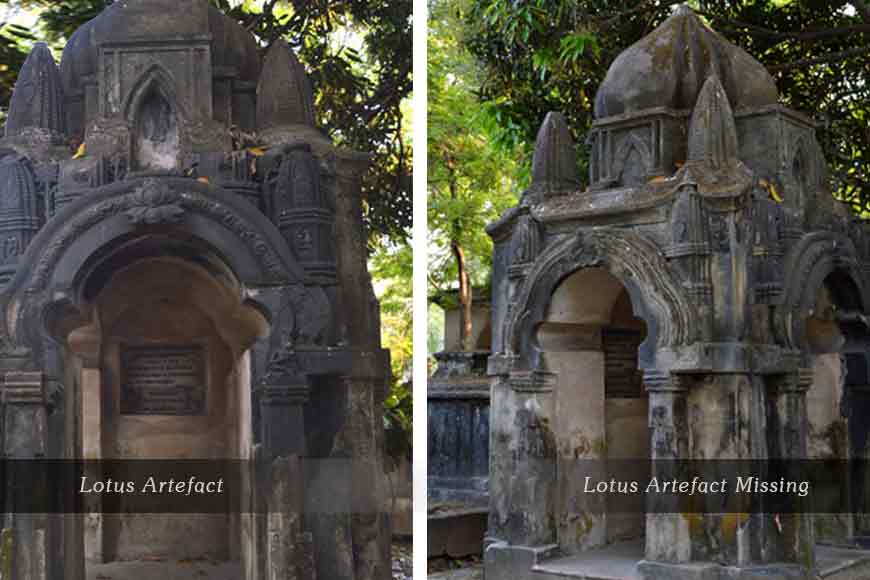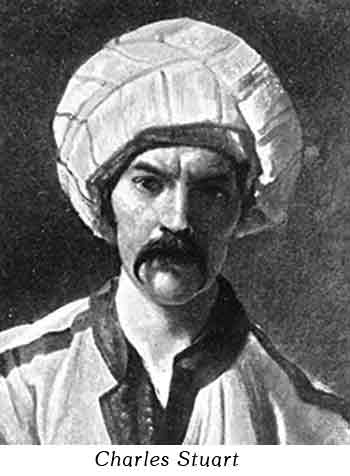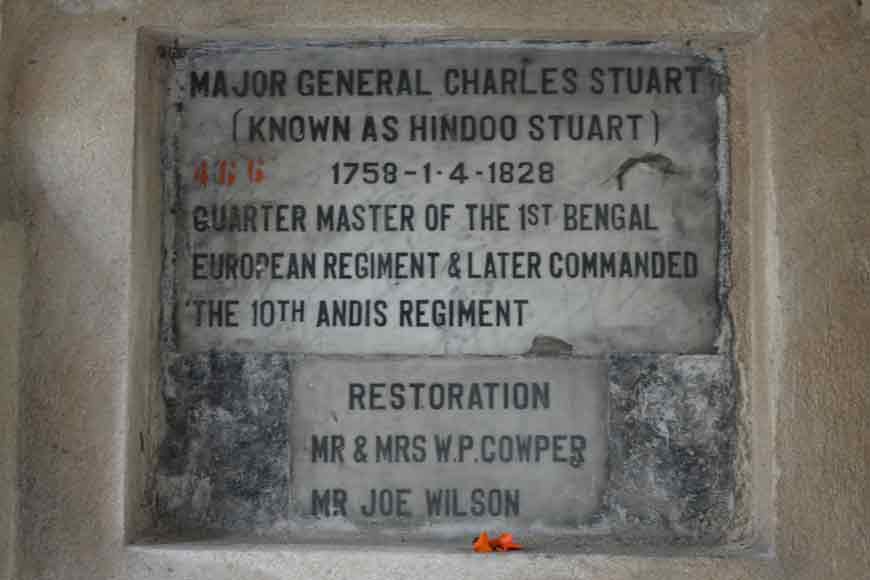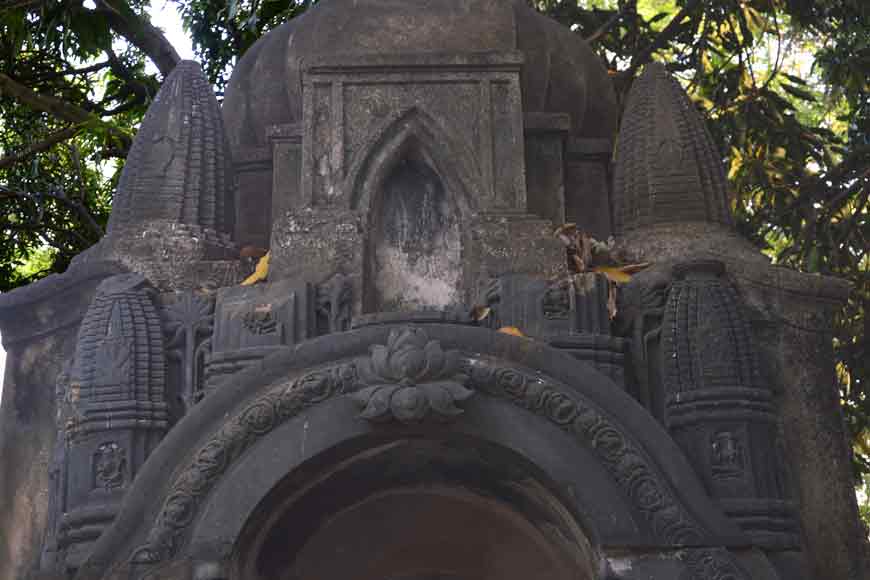Gorosthaney Shabdhan! Arpita Chanda turns detective and locates a Missing Lotus from a famous grave in South Park Street cemetery

 ‘Charles Stuart --- Quite a character!’…. a statement made by Lady Maria Nugent, the wife of General George Nugent, the Commander-in-Chief of India (1811). Well the comment is about someone who the British society criticised as ‘Hindoo Stuart’ and ‘natives’ honoured him as ‘Pundit Stuart’ or ‘General Pundit’ and the Baptist Missionaries defamed as ‘Idol-stealer.’ Well, this colourful character became a symbol of shame for the British society of India, especially for residents of Sahebpara of Chowringhee.
‘Charles Stuart --- Quite a character!’…. a statement made by Lady Maria Nugent, the wife of General George Nugent, the Commander-in-Chief of India (1811). Well the comment is about someone who the British society criticised as ‘Hindoo Stuart’ and ‘natives’ honoured him as ‘Pundit Stuart’ or ‘General Pundit’ and the Baptist Missionaries defamed as ‘Idol-stealer.’ Well, this colourful character became a symbol of shame for the British society of India, especially for residents of Sahebpara of Chowringhee.
I met Charles Stuart, all of a sudden during one of my visits to The South Park Street Cemetery, which is one of the oldest non-church cemeteries of the world. After meeting ‘him’, I became very curious. What an interesting character he was! Yes, was, I met him at his grave which is very different from the other graves in this graveyard. It is like a temple. ‘A temple in a Christian graveyard!’ – This was my first expression after seeing the grave.
Stuart was an officer in the East India Company. He was born in 1758 in Dublin, Ireland. His father, Thomas Smyth, was an Irish politician. On 9th February, 1777 at the age of 19, Charles Stuart left Ireland for India as a cadet in the East India Company’s Army and for the rest of his life he remained in India. From a general cadet he was gradually uplifted to the position of Major-General. From his obituary and Fisch’s study, it is clear he was promoted to Major General by 1814, commanding regiments of the native infantry. His last command was Saugor Field Force. Surprisingly, Stuart adopted many Hindu rituals and customs in his daily life, like bathing in the Ganges daily and practice of idolatry. He collected Hindu deities from across the country and traversed the road after a Ganga snan, chanting the Ganga Staab (Hymn in praise of Devi Ganga). Stuart firmly believed he was a Hindu and acted like one, even greeting Indians he met with as ‘Sitaram’ call.
In the biography of Stuart, V.C. P. Hodson mentioned: “He had studied the language, manners and customs of the natives with so much enthusiasm, his intimacy with them .....obtained for him the name of Hindoo Stuart.” Charles Stuart ‘went native’ as the Britishers coined a phrase for such events.Around 1800, he even decided to explain to the British that Hinduism should be seriously studied and greatly admired. As part of his campaign, he collected and displayed pieces of ancient temple sculpture. Stuart put together a huge collection of sculptures, designed to include ‘examples of each deity as a kind of visual encyclopaedia of religions and customs.’ He later built a museum at his home on Wood’s Street employing two local Brahmins to usher in visitors. It was one of the first serious attempts to present Indian culture in a systematic way to the European audience.

He encouraged his Indian sepoys to wear caste-marks in the forehead and to grow the moustaches in the Indian style. Even he adopted Indian clothes and this became his normal attire when off the parade ground. Declaring Indian garments best suited to the weather of India, he actively promoted their adoption by Europeans settled in India. Stuart published many letters in 1800/1801 where he tried to glorify the virtues of ‘elegant, simple and sensual’ Indian saris.At the age of 70, Stuart died and was buried at the South Park Street Cemetery with some of his idols. As he admired Hinduism, he wanted a cremation and that was his last wish. But as he was a British Army officer, British Government denied his last wish but allowed his tomb to be constructed like a Hindu Temple, with some of his personal collections like Prithvidevi, Makarbahini Gangadevi, stone Lotus and many more. The sculptures of Prithvidevi, Makarbahini Gangadevi etc were stolen earlier and this time the Lotus has been stolen.
In the year 1829 his remaining collections were sent to Britain and auctioned. John Bridge acquired a large part of the collections in the year 1830. In 1872 British Museum acquired this collection of Mr. Bridge from his heirs. Till 1943 it was known as ‘Mr. Bridge’s Collection.’But in 1943 Late Ramaprasad Chanda discovered Hindoo Stuart’s vast collections in The British Museum, which was till then recorded as ‘Bridge’s Collection.’Chanda discovered that the original owner of all those were Major Charles Stuart. He made his Will (1823) and he mentioned about this collection in his Will. According to his Will he said that this collection would be sent to England after insuring it for 30, 000/- Rupees. Mr. John Bridge bought most of the collection in 1830.
Now this collection is the part of British Museum’s Oriental collection in the name of ‘Major General Charles Stuart’s Collection.’ From British Museum’s website, we learn that Stuart was a collector of Indian sculptures principally from Bihar, Bengal, Orissa and Central India. His collections had weaponry, costume, prints, natural history specimens and a library.’

During his lifetime, he made a stir in Indian British society. Elizabeth Fenton in her journal wrote: “There was an Englishman, born and educated in a Christian land, who has become the wretched and degraded partaker of his heathen worship, a General S – who has for some years adopted the habits and religion, if religion it be named, of these people; and he is generally believed to be in a sane mind.”
But whatever he was, an idol -stealer, an insane or a person who was in love with Hinduism and natives, he is an interesting character of Indian history and his grave is one of the beautiful graves of The South Park street cemetery. And his grave was vandalised several times before and this time again, one artefact goes missing!









